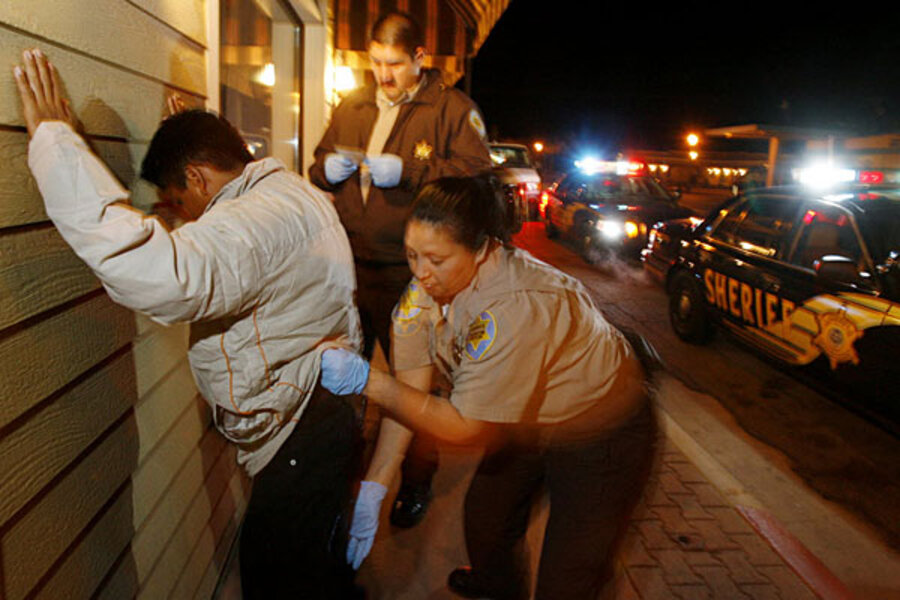Study offers clues about US illegal immigration patterns
Loading...
| Atlanta
For the first time since the 1940s, Florida saw more people moving out of state in 2009 than migrating into its recession-struck suburbs. Included in that historic economic exodus were hundreds of thousands of the state's illegal immigrants.
To be sure, states like Arizona and even some Virginia counties have also seen illegal immigrants move away as lawmakers enacted tough state illegal immigration laws, with some leaving the US altogether.
But even as the total number of illegal immigrants in the US fell from 12 million in 2007 to 11 million in 2008, a drop attributed to the sharp decline in the US economy, the numbers rose in the relatively prosperous states of Texas, Louisiana, and Oklahoma, which enjoy a low cost of living and lower-than-average unemployment.
According to a new Pew Hispanic Center survey, the trend for those states continued from March 2009 through March 2010, a period which saw only a slight uptick in the number of illegal immigrants nationwide. The pattern strengthens the notion that job opportunity – or lack of it – still is the main motivation for unauthorized migrants plying America's underground job market.
The Obama administration's priorities have been shifting on the enforcement of immigration laws, ending dramatic work place raids and having immigration officers focus deportation proceedings primarily against those who have broken other laws. But enforcement actions, for their part, have more of a chessboard effect as mostly young Hispanic workers make risk-reward settlement decisions for themselves and their young families.
After falling from its 2007 peak, the number of illegal immigrants in the US rose from 11.1 million to 11.2 million between March 2009 and March 2010, according to the new Pew study. Because of a wide margin of error in counting illegals, Pew did not overtly call the count an increase over he previous year.
The Pew survey, based on Labor Bureau and Census records, shows an immigrant population in flux – highly mobile and opportunistic, but susceptible to the demands of both the US economy and society, says Mark Krikorian, director of the Center for Immigration Studies.
"Both the economy and enforcement impact people's decisions, and what we're seeing now is a kind of limbo period where the economy isn't getting worse and enforcement isn't getting any stronger, but it's not really being totally abandoned either," says Mr. Krikorian.
Under both the Bush and Obama administrations, the Department of Homeland Security doubled the number of border patrol agents between 2004 and 2011, with over 20,000 agents now working the border. An estimated 850,000 illegal border crossers in 2005 shrank to only 350,000 in 2008. Since then, the Department of Homeland Security has seen another 36 percent reduction in the number of border apprehensions, according to DHS Secretary Janet Napolitano.
The Pew survey, however, "suggests the number of new unauthorized immigrants entering the country is balanced by those leaving," says Pew demographer Jeffrey Passel, lead author of the study. He added that there is no proof that illegal migrants are moving out of the US in growing numbers.
By the same token, there's a body of evidence emerging that shows that tough anti-illegal immigration laws in places like Arizona and Virginia have played at least some role in those states seeing reductions in their overall populations since 2009. A Migration Policy Institute study released this week showed that illegal immigrants in two northern Virginia counties where police stepped up enforcement moved to more tolerant counties nearby.
But more critically, poor economic circumstances in places like Florida and Nevada have likely led to declines in those states while stronger economies, notably in Texas, Louisiana and Oklahoma, have become migration magnets, seeing a net growth in the number of unauthorized migrants since March 2009
"We have historically seen the growth patterns track fairly close with the US economy, but we've also seen in the last couple of years some very substantial changes in the enforcement mechanisms and patterns," says Mr. Passel.
The results may sway a looming debate, promised by Mr. Obama in his State of the Union speech, about another attempt at comprehensive federal immigration reform.
For one thing, the Pew findings that 80 percent of the of 5.5 million children born to illegal immigrant parents were born in the US, and are thus citizens, could fuel simmering debate from some on the American right about repealing the 14th Amendment, which guarantees citizenship to those born on US soil. While illegal immigrants make up 5 percent of the US workforce, children with at least one illegal immigrant parent made up 8 percent of US births in 2009.





